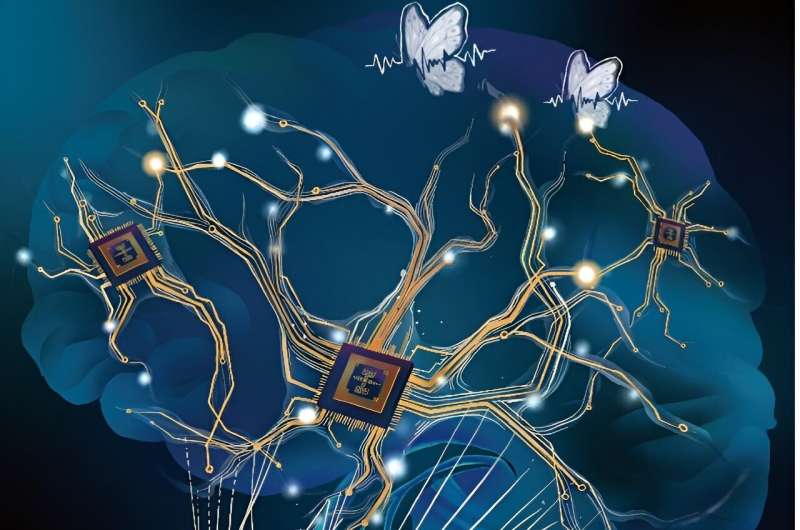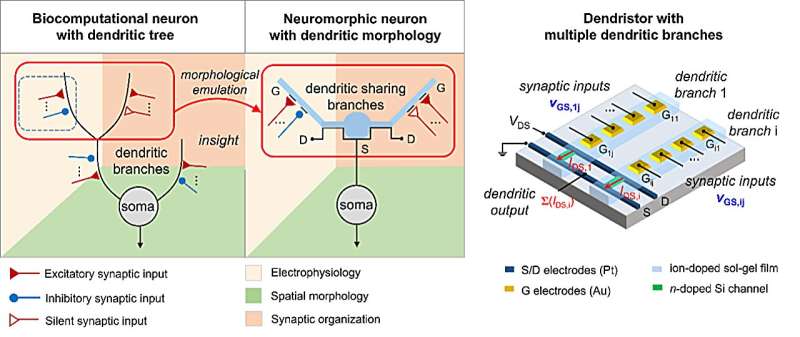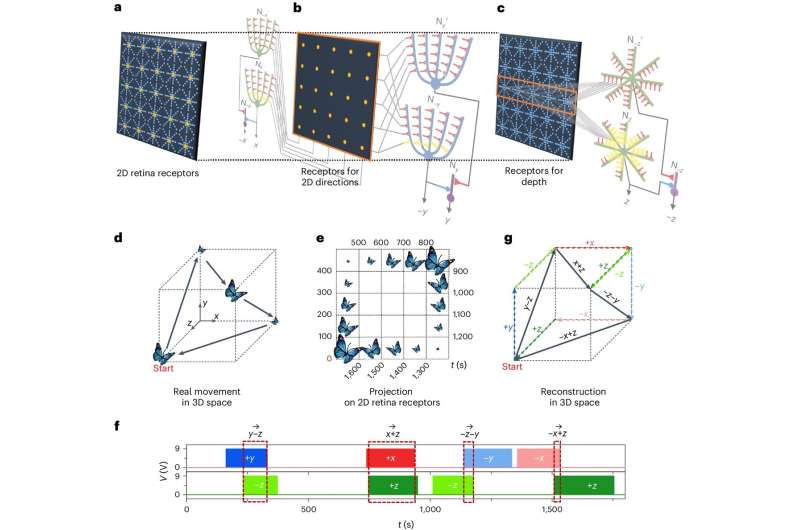July 5, 2024 feature
This article has been reviewed according to Science X's editorial process and policies. Editors have highlighted the following attributes while ensuring the content's credibility:
fact-checked
peer-reviewed publication
trusted source
proofread
A new brain-inspired artificial dendritic neural circuit

Following the rapid advancement of artificial intelligence (AI) tools, engineers worldwide have been working on new architectures and hardware components that replicate the organization and functions of the human brain.
Most brain-inspired technologies created to date draw inspiration from the firing of brain cells (i.e., neurons), rather than mirroring the overall structure of neural elements and how they contribute to information processing.
Researchers at Tsinghua University recently introduced a new neuromorphic computational architecture designed to replicate the organization of synapses (i.e., connections between neurons) and the tree-like structure of dendrites (i.e., projections extending from the body of neurons).
This new brain-like artificial system, introduced in a paper published in Nature Electronics, was realized using a computational model of multi-gate silicon nanowire transistors with ion-doped sol-gel films.
"When I was a master student in AI and brain bioengineering at the Polytechnic of Milano in Italy, I conceived the idea to emulate brain connectivity sparsity and morphology, such as that of the neuron's dendrites, to design efficient AI," Carlo Vittorio Cannistraci, one of the corresponding authors, told Tech Xplore.
"I also was fascinated by the elegance of brain-mechanisms such as the 'silent synapses' which turn on their functioning when they are surrounded by an increased electrical activation."
Drawing inspiration from his previous studies and research interests, Cannistraci recently set out to realize complex brain mechanisms computationally. As part of this recent study, he teamed up with other researchers at Tsinghua University to replicate the morphology of dendrites and the underpinnings of synapses using a neuromorphic computing model.
"One day, Carlo asked me to study 'Dendritic Computation' since our previous collaborative study on 'neurotransistors' had the potential to mimic the dendritic properties," Eunhye Baek, one of the corresponding authors, told Tech Xplore.
"Prof. Luping Shi and I had been seeking ways to develop a neuromorphic visual sensor system, and we recognized the potential in this approach.

"My interest has always been to build more brain/neuron-like dynamic information processing system. Dendritic computation excited me greatly, because it encompasses a wide range of dynamic and complex properties, which have not yet been extensively studied in neuromorphic engineering."
Most neuromorphic computing research carried out so far focused on reproducing synaptic processes associated with learning and artificially replicating the generation of neuronal spikes. These studies often modeled dendrites as simple transmission lines, thus ignoring the functions associated with their unique morphology.
"Dendrites utilize their tree-like morphology for mapping spatially distributed signals, exhibiting branch-specific plasticity, and integrating various synapses," Baek explained.
"Each dendritic branch is particularly sensitive to signals with specific directionality, making them specialized for processing spatiotemporal signals. Our research focuses on these complex dendritic functions."
Cannistraci, Shi, Baek and their collaborators designed and developed a new device that mirrors the morphology and function of biological dendrites. This device, dubbed "dendristor," mimics the computations performed by dendrites, by leveraging the physics of multi-gate transistors coated with an ion-doped sol-gel film.
"This film imitates dendritic branches by allowing doped ions to move similarly to ions in neuronal dendrites, modulating the transistor's current to reflect changes in dendritic membrane potential," Baek said. "Our study demonstrates that the dendristor exhibits nonlinear dendritic integration and direction selectivity."
In addition to the dendristor device, the recent paper by this research group introduces an artificial silent synapse. In this system, the voltage of the dendristor's branches in the sol-gel film ensures that synaptic inputs only activate when the film reaches a specific threshold, thus improving the system's ability to discern the direction of moving visual stimuli.
"We also created a neuromorphic dendritic neural circuit that computes the direction of moving signals, inspired by the neural circuits of the retina and visual cortex," Baek said. "This circuit shows the ability to detect signals moving in 2D and depth, integrating them to reconstruct the movement direction of objects in 3D space."
By closely mirroring the sparse connectivity of dendritic neurons, the new neuromorphic computing approach introduced by Cannistraci, Baek and their colleagues was found to attain remarkable energy efficiencies. In fact, this system demonstrates the potential to detect motion utilizing fewer neurons than existing artificial neural networks (ANNs).

The key advantage of this new architecture is that it reaches beyond replicating the functional aspects of biological neurons. In contrast with other existing neuromorphic computing platforms, it also reproduces the structure and sparse connectivity of neurons, including the morphology of dendrites and the underpinnings of silent synapses.
"Although there are various approaches in neuromorphic research to realize the intelligence, our study uniquely shows the importance of neuronal and their synaptic connection morphology in dynamic signal processing," Baek said.
"We achieved this by mimicking the way biological neurons form functional neural circuits with spatially sparse mapping of synaptic inputs, highlighting how crucial this morphology is for efficient neuromorphic information processing."
Notably, this research team was the first to demonstrate that the spatial position of inhibitory and silent synapses can also control the processing of signals by neurons in neuromorphic systems. This insight could guide the design of other computational models and architectures that reproduce silent synapses.
"Sparsity and morphology have been poorly understood and employed to build next generation AI," Cannistraci said. "Our study is the first to show how to leverage these two features of real brain networks to design next generation neuromorphic neural networks for efficient AI."
The recent efforts by Cannistraci, Baek and their colleagues could soon open new and exciting avenues for the engineering of neuromorphic systems based on semiconductor devices. Specifically, their proposed brain-inspired design could contribute to the development of new devices and AI tools that consume less energy, thus paving the way for more sustainable computing.
In their next studies, the researchers plan to further extend their artificial neural circuits, using advanced inhibitory connections that could further boost the classification of dynamic visual signals. To do this, they will try to closely mimic the neural connections observed in the brain at its early stages of development.
"We plan to develop new neuromorphic dendritic network architectures that perform deep learning and can solve other AI tasks beyond visual perception, such as time series analysis and auditory tasks," Cannistraci added.
"In addition, we wish to develop multimodal circuits able to process and correlate sensory inputs of different types such as visual and acoustic together. Finally, we would like to extend this sparse and morphological computing paradigm to classical types of artificial neural networks which are implemented on digital hardware."
More information: Eunhye Baek et al, Neuromorphic dendritic network computation with silent synapses for visual motion perception, Nature Electronics (2024). DOI: 10.1038/s41928-024-01171-7
© 2024 Science X Network


















